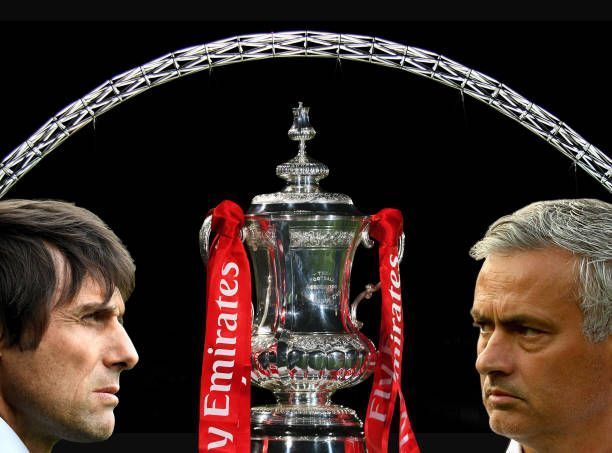
FA Cup Final: Manchester United vs Chelsea- A Tactical Battle
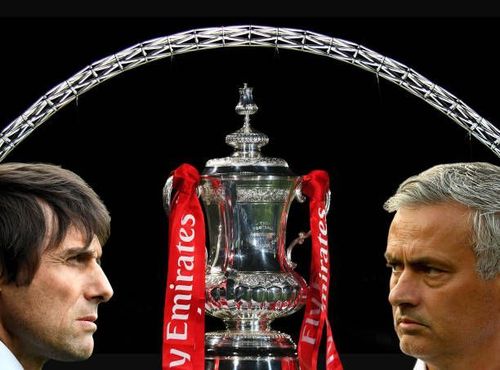
The final of the FA Cup will take place at Wembley this Saturday. Often called the most important date in the English football calendar, FA Cup continues to hold extreme relevance even today. The glory of lifting that prestigious trophy in the biggest stadium of England is unmatched. Hence teams often put their best foot forward in the final domestic match of the season.
However, this time, a major part of the battle is going to be fought in the tactical room of both the teams. Jose Mourinho and Antonio Conte are two revered managers in European football. However, one thing that's common between them is their tactical acumen, which has been revolutionary in the Premier League. Both Jose and Conte have influenced the Premier League and brought their own, new sets of ideologies that have stood the test of time.
Hence, when these two gaffers line their team up for the clash at Wembley, a lot of work would have been done in setting their team up for the match. Both these managers have a personal animosity between them too, and hence it would be interesting to see who thumps who when their players take the field at Wembley. Here, we analyze the formations that these two teams can undertake when they face off each other:
Manchester United
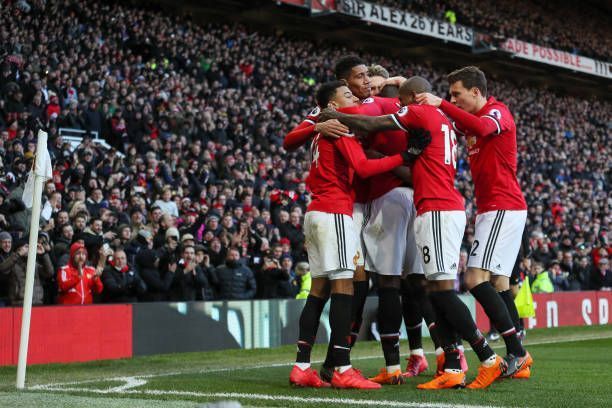
Jose Mourinho has been quite flexible with his formations throughout the season. However, he has kind off resorted to playing a 4-3-3 setup in the past few months. Meanwhile, Romelu Lukaku’s injury has prompted me to suggest two formations for United; one with him, and the other without him.
The 4-3-3: Defensive Shape (with Lukaku)
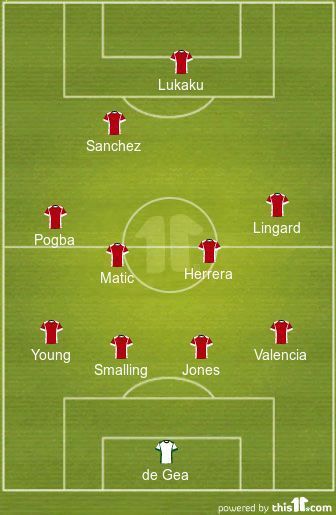
Usually, Manchester United play Alexis Sanchez, Romelu Lukaku, and Jesse Lingard as the three forwards in the 4-3-3 formation. This allows the front three to have positional freedom while attacking as they have the tendency to shift positions according to the nature of the play. However, one thing that is often overlooked is the fact that Mourinho always prefers Lingard and Sanchez as the wingers ahead of Anthony Martial.
This has a lot to do with Lingard’s incessant energy on the pitch. The Mancunian is a tireless runner and is very industrious as soon as the team loses the ball. Statistically, United keep 54% of the possession of the ball in the Premier League. Hence, in the time when the team is chasing the ball, Mourinho tasks Lingard to drop back to act as the fourth midfielder. This forms a four-man traditional midfield base to protect the defence.
Lingard is often seen tracking back the runner on the right-hand side of the pitch and acts as a foil to Antonio Valencia. He helps the Ecuadorian while pressing the opposition on the extreme right side of the pitch. For example, look at Paul Pogba’s goal against Arsenal at Old Trafford a couple of weeks ago. Valencia put pressure on Reiss Nelson on the right-hand side, and Lingard dropped back at the halfway line to collect the ball.
He then passed it on to Pogba, which eventually led to a goal. Mourinho admires Lingard’s tenacity while playing as a wide-man and that helps him have a defensive balance in the 4-3-3 formation. Even Paul Pogba is instructed to shunt out a bit wide so that he provides some defensive cover to the makeshift left-back Ashley Young. Pogba tracks the opposite right-winger and tries to thwart off attacks even before the ball reaches to Young.
However, both Young and Pogba like to go ahead and their positional discipline has regularly been under scanner. To maintain a proper balance on the field, it is necessary that both of them agree to the manager’s demands of staying back whenever the team loses the ball. They were quite well positioned and disciplined against Spurs in the semi-final as Pogba went behind to win balls and then started attacks with some slick passes in that game.
Against a well-drilled Chelsea side, United cannot afford to lose their shape as they did for Dele Alli’s goal in the same semifinal match. When Davinson Sanchez had released a ball from the backline for Eriksen to chase, Young was nowhere in the scene and Pogba couldn’t track him back fast enough to stop the Dane’s cross inside the box. Though United fought back well in the game courtesy to Pogba himself, a replica of that goal should be avoided from United’s perspective.
When Pogba and Lingard cover their fullbacks, there is a lot of space left in the centre. Here’s when playing a three-man midfield helps, as Ander Herrera and Nemanja Matic close down spaces effectively well in the middle of the park. Herrera’s bite and energy help him move the ball ahead quickly. He is aware enough to put pressure on the opposition before the ball is passed to the backline.
Where Herrera relies on winning the ball through tackles, Matic tends to intercept the ball with his positional awareness. Both of them sit around the halfway line in an attempt to win the ball higher up on the pitch. Matic always looks better equipped when he is partnered by Herrera, as both of them solely concentrate on winning the ball whenever the team is dispossessed. Herrera’s speed enables him to quickly shut down any openings in the midfield. United tend to outnumber the opposition at the centre in order to absorb attacking pressure ahead of the backline. More interestingly, Sanchez drifts inside and tries to win the ball in the opposition half itself. The Chilean’s game has always been based on energy and constant running on the field.
His defensive contribution helps United in recovering the ball in dangerous areas in the opposition half. There is an urge in him to repeatedly win the ball back as soon as he loses it, and hence Sanchez leaves no stone unturned in order to help his midfield when the team loses the ball.
Often, in a 4-3-3 formation, two forwards position themselves in the opposition box. However, Sanchez falls a bit deeper than usual. He is also effective in transitioning defence into attack and that’s the reason why his presence is extremely essential even without the ball.
The 4-3-3: Attacking Shape (with Lukaku)
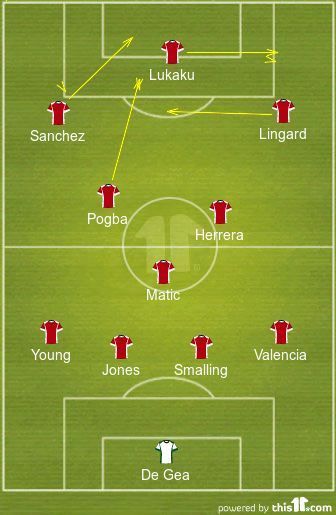
Manchester United’s attacking shape in the 4-3-3 formation is quite traditional as they look to attack with four men, with Ander Herrera playing the role of the quintessential box-to-box midfielder. His winning goal in the semifinal against Spurs defines Herrera’s role. He first cleared a ball safely to the keeper, and then rushed ahead to the opposite box in order to score the goal through a quick counter-attack. His energy and tenacity help the midfielder to carry out this role with perfection.
Meanwhile, Chris Smalling and Phil Jones are often very reserved in possession. Smalling particularly has been unable to play the ball out from the back and hence either Nemanja Matic or Paul Pogba have to drop deeper to orchestrate the play. Usually, Matic collects the ball and passes it to Pogba on the left Pogba, then forms passing triangles with Herrera and Lingard in the opposition half. As an LCM, Pogba tries to get into short spaces in the midfield.
Hence, one can see him drifting inside in the central attacking midfield position. From here, he can either pass sideways or pick out the man in the box with a straightforward pass. Most of the times though, the Frenchman uses his dribbling prowess to pick the left-wing slot, as Alexis has a tendency of cutting inside to use his preferred right foot.
This way, Lukaku then shifts out a bit wide, as he can send in some good crosses. This has bee visible throughout the course of the season. United’s attacking gameplay is very fluid, as the players are quite well aware of their positions despite not having played a lot together. Alexis gets in goal-scoring positions and Pogba drifts wide, or Pogba makes the run through the centre and Alexis tries to feed him from the left flank.
There is adaptability when these two players are considered, as both of them have looked to be at their best whenever United play a three-man midfield. Meanwhile, Lingard looks to come inside from his right-wing too. To be honest, Lingard’s best attacking moments come when the team attacks on the break, as his pace and dribbling, make him a menace during counter attacks.
Otherwise, most of United’s offensive play is concentrated through the left-flank. This is due to the sheer quality of the players on that side of the pitch. Hence, Lingard has to shift behind Lukaku and take a part in the passing triangles that are usually initiated by Pogba. All this time, Alexis gets around the edge of the box and tries to play in some cheeky balls to Lukaku who stations himself on the right-hand side of the goalpost.
United can bring in more cohesion in their attacks, and Lukaku’s hold up play through which he brings the other forwards into the attacking moves is very important. It is surely something that the team would miss if the Belgian fails to recover in time from his ankle injury.
The 4-3-1-2: Defensive Shape (without Lukaku)
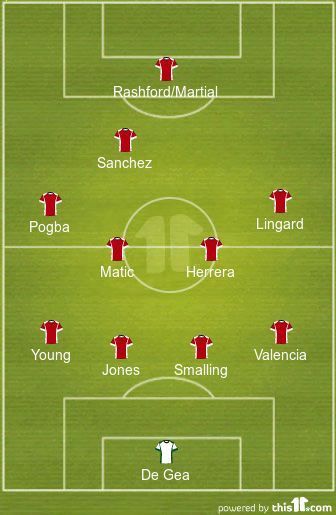
First of all, without Romelu Lukaku, Manchester United will most probably shift to a narrower 4-3-1-2 formation with Alexis and Martial/Rashford upfront. However, the defensive aspect of this formation will be quite similar. This is because, even here, a four-man midfield base will be arranged so that the backline could be protected thoroughly.
Lingard will be playing in the hole behind the two strikers, but he would have to move out wide and deep in order to break attacks. Jose always likes to put men behind the ball. He likes to start counter-attacks by winning the ball in the midfield. Hence Lingard’s presence on the right side would be important to put pressure on the opposition's midfield.
If you take a closer look at United’s defensive formation, it is a man-to-man protection for each defender. Valencia has Lingard to help him on the right-flank, and accordingly Smalling, Jones and Young would have Herrera, Matic and Pogba respectively. As visible, the left-hand side of this formation is the most vulnerable, and Chelsea might try to tackle that by bringing in the pace and direct dribbling of Willian.
The Brazilian winger scored the only goal for Chelsea when the two sides met in February and he could be a major threat for United once again. Moreover, if the Brazilian is able to peg back Pogba, then United’s creative moves will take a huge blow. Hence it needs to be ensured that Young does not commit any positional error that allows Willian to work his way into space on that wing.
Alexis will once again drop a bit down on the field and he would pretty much be United’s creator-in-chief. However, it must be ensured that he does not drop way too deeper to win the ball, as any such move would devoid United of a whole lot of creativity in the final third.
Amongst Sanchez and Pogba, only one should be tasked with defensive duties, as the other should be free to collect the ball and launch an attack as soon as the team recovers the possession. Sanchez’s willingness to work without the ball will help Martial/Rashford as Alexis’ forward partner could station himself in threatening goal-scoring positions.
The 4-3-1-2: Attacking Shape (without Lukaku)
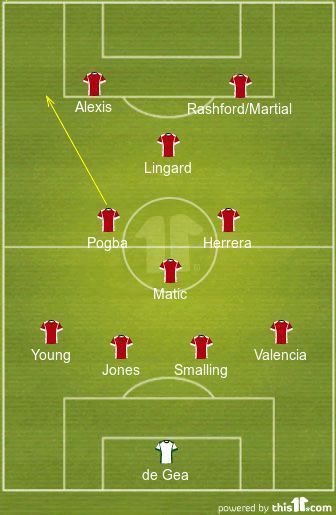
To be honest, this formation does not provide much tactical flexibility to the manager, and the players would hardly rotate around their positions as they do so effectively well in the 4-3-3. However, Pogba can certainly occupy the left wing slot, as Sanchez would be playing slightly inwards to fulfill his role as that of a creative forward. Hence, amongst the four attacking players, in my opinion, only Pogba will have the freedom to move across the field to put in testing deliveries into the box.
Jesse Lingard will be playing in his favored position behind the strikers. As witnessed in the first half against Swansea at the start of April, Lingard has the ability to create a whole lot of space near the penalty box with his intelligent movement off the ball. While Pogba would look to get in these spaces in order to make decisive passes, Sanchez could play inside the box.
Pogba’s interference in attack would be essential due to the fact that Lukaku’s absence might deprive United of any kind of strong physical presence in the penalty box. Gary Cahill was physically imposing and used his aerial threat to good effect in Chelsea’s victory against Liverpool.
Hence, Lukaku might have helped to neutralize that aspect of Chelsea’s back three, and would have kept Cahill preoccupied; which, in turn, would have helped the other forwards to work their way through the space vacated by Cahill. If Lukaku doesn’t recover in time, Pogba could be used as someone who can trouble Cahill with his aerial prowess.
However, in such case, Matic and Herrera will have to stay extremely concentrated as N’golo Kante will drive Chelsea ahead with precision. This attacking formation is quite narrow and leaves the fullbacks exposed on the wing too. United’s makeshift fullbacks will have to most probably face the likes of Eden Hazard and Willian.
A narrow formation such as this one could leave the fullbacks vulnerable in a one-on-one situation. Hence Jose might have to figure something out regarding this if he decides to field his team in the 4-3-1-2 formation. Chelsea’s wingbacks like to maraud forward through the flanks, and it makes up to be an interesting clash of tactics if Jose is forced to use this due to Lukaku’s absence.
If Sanchez and Martial/Rashford play upfront, United will be required to play through the middle of the park more often than not. This is because of the fact that Cahill and Azpilicueta can defeat the United duo in the air. Playing through the centre would be even more difficult considering that Kante has slowly recovered his old form and has carved a niche for himself at breaking down attacks at an alarming rate.
United’s attacking moves will have to be swift and quick, as allowing Kante to come near any loose balls can prove out to be costly. This 4-3-1-2 or the midfield diamond formation will bring its own sets of questions for the manager.